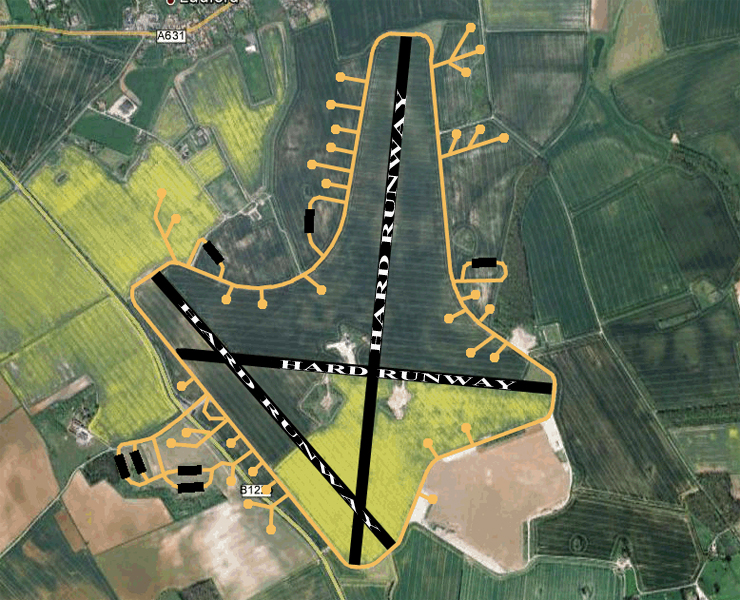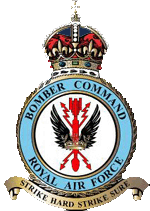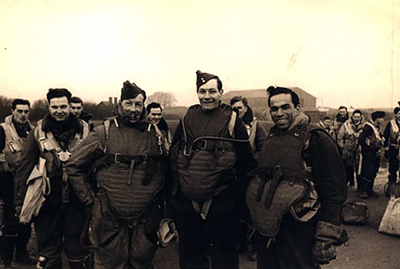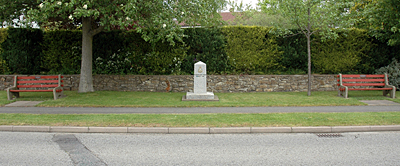Ludford Magna Airfield History

(Map edited to show runways)

© Crown Copyright/MOD 2010
53°22'19.6"N 0°11'51.3"WRunways:
11/29 & 15/33 4200ft x 150ft -02/20 6000ft x 150ft
The site that was to become RAF Ludford Magna was first examined in June 1942 for use as a airfield. By the end of that same month a contract had been awarded and work had begun. The contract was awarded to George Wimpey, at a cost of £800,000. The land chosen was located five miles east of Market Rasen, directly south of both the A631 and the village of Ludford, and owned by the Hilldred family. The usual 36 hardstandings adjoined the perimeter track and all but one were pans. Two other pans were lost due to the erection of four T2 hangars off the southwest perimeter in the technical area. A lone T2 hanger was located on the east side of the airfield and a B1 and T2 on the station technical site near the village itself, between the heads of runways 15 and 20. A road on the west side from the A631 to the A157 was crossed by dispersals in this area. Domestic and communal sites were dispersed in farmland to the north of the airfield. There were seven domestic, two mess, a communal site and sick quarters, giving a maximum accommodation off 1953 male and 305 female personnel.
The location of the airfield (430ft above sea level) meant it was the highest of all airfields in Lincolnshire, and one of only a few that had it's main runway running north to south. The problem with this was that this provided a problem to all aircraft, especially Avro Lancasters, who had to deal with strong cross-wind conditions on this exposed hilltop airfield.
Having taken nearly a year to build, the station finally opened on 15th June 1943, and soon after become the new home of No.101 Sqn as part of 1 Group, Bomber Command, bringing with them their Avro Lancasters. In October, as well as being part of the main force, the squadron was given the additional and unique role of operating radio-countermeasures employing the “Airborne Cigar” (or ABC as it became known) device. But in order to carry this out an extra crew member was needed to transmit in German on the German’s fighter control frequencies. The aim was to confuse the fighters with false information and thus giving the upper hand to the RAF.
The squadron immediately suffered it's first loss when Lancaster ED650, piloted by Sgt D.H. Brook, was shot down near Monchengladbach on the night of the 21st-22nd only a week after their move to their new home. This bad luck continued on their next two raids losing a single aircraft on both, and two aircraft on their third raid, during an attack on Gelsenkirchen. But the squadrons worst night was yet to come. On the night of 30th/31st March 1944, the squadron was to provide 26 ABC equipped Lancasters for a force of 795 bombers due to attack the German city of Nuremberg. It turned out to be one of the worst nights for Bomber Command during WWII, as 96 aircraft were lost, seven of these were from No.104 Sqn, almost a third of the entire squadron.
To add insult to injury, the squadron was to go through a near repeat of this tragedy only six weeks later when five Lancasters were lost during a disastrous attack on German tank formations at Mailly-le-Camp, just west of Paris. A total of 42 Lancasters were lost that night, 28 of them were from 1 Group squadrons.

© Unknown - No.101 Sqn Jan 1944
October 1943 saw more changes at the station when it took Wickenby over as a satellite and by the 15th December had become the Headquarters of 14 Base, which controlled the sub stations at both Wickenby and Faldingworth. To help with increased duties additional hangars were built and 14 Base Major Servicing Unit was eventually formed their on 14th April 1944. In November 1943 the Station prepared to receive a proposed second flying squadron, No.576 Squadron, the nucleus of this squadron was to be formed from 4 crews of No.101 Squadron and other crews from No.103 Sqn at Elsham Wolds. In the end the atrocious mud and limited infrastructure at Ludford led No.576 Squadron to be formed at RAF Elsham Wolds, and the airfield gaining the nickname “Mudford Magna”.
The next unit to take up residence at Ludford was No.1682 Bomber Defence Training Flight in April 1944. But their stay was short lived, and they were moved on in July the same year. By the end of October 1944, beam approach equipment had been installed at the airfield but was found not to be up to standard. So the station was later enhanced with FIDO for fog dispersal and the station was allocated a Airspeed Oxford for trials work and communication duties. The addition of FIDO to the airfield made Ludford the first station within 1 Group, Bomber Command and only one of a handful of RAF stations to have the equipment.
Along with being the home of the first Lancasters to be equipped with ABC, it was also the home of another innovation for the Lancaster. The Rose Turret, which replaced the Fraser-Nash rear turret, was first fitted to No.101 Sqn Lancasters while at Ludford. The new turret was fitted with two .5" machine guns, replacing the standard .303s. Along with this the size of the turret was increased which in turn now meant that the gunner could now keep his parachute on. The new size also increased the visibility the gunner had, and due to changes in the slipstream, now meant the gunner was also a lot warmer.
The first bomber attack against Ludford took place on 4th March 1945, but the damage was restricted to a small crater and some canon fire.
With the end of WWI and the post-war re-organisation of Bomber Command, No.101 Sqn was moved to RAF Binbrook on 1st October 1945, and in turn Ludford became a sub-station of Binbrook. With the departure of the squadron from the airfield, so with it any further flying and the skies fell silent. During operations from Ludford Magna, 113 Lancaster's failed to return to the airfield or crashed.
Finally on 15th December 1945, RAF Ludford Magna was placed on Care and Maintenance and all flying ceased at the station, although the runways were kept open for emergency use only. Over the next few years the airfield was slowly handed over to the Ministry of Agriculture for cultivation between the runways. But this was not the end for station, and in 1958 part of the old RAF station was handed back to the Air Ministry for use as a Douglas Thor missile site. After the work to convert the station had finished, No.104 Squadron was formed their on 21st July 1959.
The role of No.104 Sqn was to operate three Thor IRBM missiles within the RAF Hemswell Missile Wing. But this was to last for only a few years, and in May 1963 the missiles were withdrawn from the airfield. In turn this led to No.104 Sqn being disbanded on 24th June the same year, and the station placed back on Care and Maintenance. The entire 580 acre site was finally sold-off during 1965 and 1966.

© Richard E Flagg - RAF Ludford Magna memorial
Today very little of the airfield remains, with most of the concrete runways having been torn up, and the land returned back to agricultural use. All the hangars were sold-off and dismantled, although many buildings survive for small business use today. From the air the former Thor IRBM missile pads can still be clearly seen, but this is the only visual reminder were the airfield once was.
The most poignant reminder of the stations existence is the memorial to No.101 Squadron erected in 1978 on the main road through Ludford Magna village. The memorial was unveiled by Air Vice-Marshall R Blucke CB, CBE, DSO, who was the first Station Commander at Ludford. During the unveiling, a No.104 Sqn (now flying the Avro Vulcan) aircraft made two low passes over the village.
| Date | Squadron | Notes |
|---|---|---|
| June 1943 | Station opened. | |
| June 1943 | No.101 Sqn | Operating the Avro Lancaster. Left Ludford Magna 1st October 1945. |
| April 1944 | No.1682 BDTF | The Bomber Defence Training Flight left Ludford in July 1944 |
| 1944 | Station Flight / FIDO Trials | Operating the Airspeed Oxford. Left Ludford Magna in 1945. |
| December 1945 | Station placed on Care and Maintenance. | |
| February 1950 | No.93 MU | The Maintenance Unit left Ludford Magna in September 1952. |
| September 1952 | No.92 MU | The Maintenance Unit left Ludford Magna in June 1956. |
| June 1956 | No.93 MU | The Maintenance Unit left Ludford in October 1958. |
| 1958 | Station placed on Care and Maintenance. | |
| July 1959 | No.104 Sqn | Operating the Thor IRBM missile. Squadron disbanded on 24th June 1963. |
| July 1963 | Station placed on Care and Maintenance. | |
| 1965-66 | RAF Ludford Magna sold-off |
